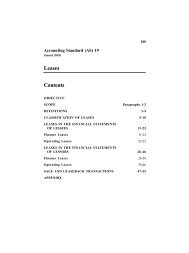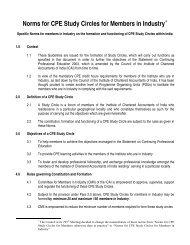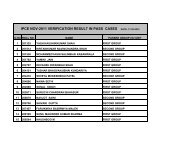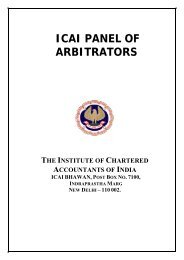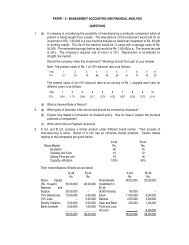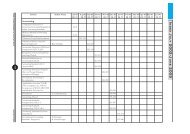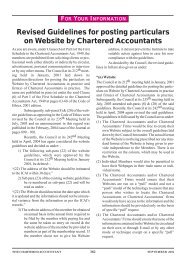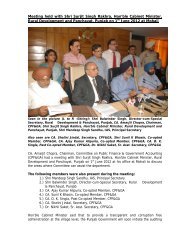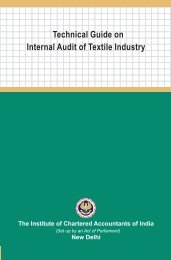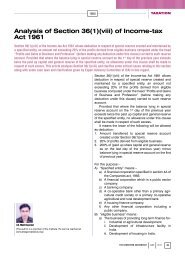The Chartered Accountant
The Chartered Accountant
The Chartered Accountant
Create successful ePaper yourself
Turn your PDF publications into a flip-book with our unique Google optimized e-Paper software.
with governance is not adequate and<br />
the situation cannot be resolved, the<br />
auditor may take such actions as:<br />
l Modifying the auditor’s opinion<br />
on the basis of a scope limitation.<br />
l Obtaining legal advice about<br />
the consequences of different<br />
courses of action.<br />
l Communicating with third parties<br />
(e.g., a regulator), or a higher<br />
authority in the governance<br />
structure that is outside the<br />
entity, such as the owners of a<br />
business (e.g., shareholders in a<br />
general meeting), or the responsible<br />
government minister or<br />
parliament in the public sector.<br />
l Withdrawing from the engagement<br />
where permitted in the<br />
relevant jurisdiction.<br />
Documentation (Ref: Para. 19)<br />
A49. Documentation of oral communication<br />
may include a copy of minutes<br />
prepared by the entity retained<br />
as part of the audit documentation<br />
where those minutes are an appropriate<br />
record of the communication.<br />
Material Modifications to<br />
ISA 260, Communication<br />
with Those Charged with<br />
Governance<br />
<strong>The</strong> SA 260, “Communication with<br />
Those Charged with Governance”<br />
does not contain any material modifications<br />
vis-a-vis ISA 260.<br />
Appendix<br />
(Ref: Para. 12(a), and A21)<br />
Qualitative Aspects of Accounting<br />
Practices<br />
<strong>The</strong> communication required by paragraph<br />
12(a), and discussed in paragraph<br />
A21, may include such matters<br />
as:<br />
Accounting Policies<br />
l <strong>The</strong> appropriateness of the accounting<br />
policies to the particular<br />
circumstances of the entity,<br />
DECEMBER 2008 1100 THE CHARTERED ACCOUNTANT<br />
STANDARDS<br />
having regard to the need to<br />
balance the cost of providing<br />
information with the likely<br />
benefit to users of the entity’s<br />
financial statements. Where acceptable<br />
alternative accounting<br />
policies exist, the communication<br />
may include identification<br />
of the financial statement items<br />
that are affected by the choice<br />
of significant accounting policies<br />
as well as information on<br />
accounting policies used by<br />
similar entities.<br />
l <strong>The</strong> initial selection of, and<br />
changes in significant accounting<br />
policies, including the application<br />
of new accounting<br />
pronouncements. <strong>The</strong> communication<br />
may include: the effect<br />
of the timing and method of<br />
adoption of a change in accounting<br />
policy on the current<br />
and future earnings of the entity;<br />
and the timing of a change<br />
in accounting policies in relation<br />
to expected new accounting<br />
pronouncements.<br />
l <strong>The</strong> effect of significant accounting<br />
policies in controversial or<br />
emerging areas (or those unique<br />
to an industry, particularly when<br />
there is a lack of authoritative<br />
guidance or consensus).<br />
l <strong>The</strong> effect of the timing of<br />
transactions in relation to the period<br />
in which they are recorded.<br />
Accounting Estimates<br />
l For items for which estimates<br />
are significant, issues discussed<br />
in Proposed Revised SA 540 14<br />
including, for example:<br />
m Management’s identification<br />
of accounting estimates.<br />
m Management’s process for<br />
making accounting estimates.<br />
m Risks of material misstatement.<br />
m Indicators of possible<br />
management bias.<br />
m Disclosure of estimation<br />
uncertainty in the financial<br />
statements.<br />
Financial Statement Disclosures<br />
l <strong>The</strong> issues involved, and related<br />
judgments made, in formulating<br />
particularly sensitive financial<br />
statement disclosures (e.g.,<br />
disclosures related to revenue<br />
recognition, remuneration, going<br />
concern, subsequent events,<br />
and contingency issues).<br />
l <strong>The</strong> overall neutrality, consistency,<br />
and clarity of the disclosures<br />
in the financial statements.<br />
Related Matters<br />
l <strong>The</strong> potential effect on the financial<br />
statements of significant<br />
risks, exposures and uncertainties,<br />
such as pending litigation,<br />
that are disclosed in the financial<br />
statements.<br />
l <strong>The</strong> extent to which the financial<br />
statements are affected by<br />
unusual transactions, including<br />
non-recurring amounts recognised<br />
during the period, and the<br />
extent to which such transactions<br />
are separately disclosed in<br />
the financial statements.<br />
l <strong>The</strong> factors affecting asset and<br />
liability carrying values, including<br />
the entity’s bases for determining<br />
useful lives assigned<br />
to tangible and intangible assets.<br />
<strong>The</strong> communication may<br />
explain how factors affecting<br />
carrying values were selected<br />
and how alternative selections<br />
would have affected the financial<br />
statements.<br />
l <strong>The</strong> selective correction of misstatements,<br />
for example, correcting<br />
misstatements with the<br />
effect of increasing reported<br />
earnings, but not those that<br />
have the effect of decreasing<br />
reported earnings.q<br />
14 <strong>The</strong> Exposure Draft of Revised SA 540, “Auditing Accounting Estimates, Including Fair Value Accounting Estimates, and Related Disclosures”, has been published in the<br />
September, 2008 issue of the Journal.



